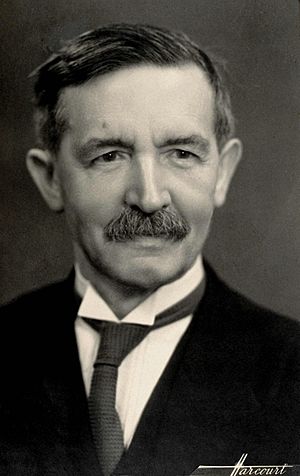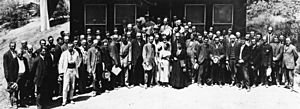Aimé Cotton facts for kids
Quick facts for kids
Aimé Auguste Cotton
|
|
|---|---|
 |
|
| Born | 9 October 1869 |
| Died | 16 April 1951 |
| Alma mater | École normale supérieure |
| Scientific career | |
| Fields | Physics |
| Institutions | University of Paris |
Aimé Auguste Cotton (born October 9, 1869 – died April 16, 1951) was a French physicist. He is famous for studying how light interacts with special types of molecules. These molecules are called chiral because they are like your left and right hands – they are mirror images but can't be perfectly placed on top of each other.
Cotton discovered that when light passes through these molecules, it behaves in unique ways. He found that the way light twists (called optical rotatory dispersion) changes a lot depending on its color (wavelength). This is known as the Cotton effect. He also found that these molecules absorb "left-spinning" light differently from "right-spinning" light. This is called circular dichroism. These discoveries became very important tools for understanding the shapes of molecules in chemistry and biology.
Contents
Biography
Aimé Cotton was born in Bourg-en-Bresse, France, on October 9, 1869. His family had a strong background in education. His grandfather was a school director, and his father was a mathematics professor. Aimé's brother, Émile Cotton, also became a well-known mathematician.
Aimé went to high school in Bourg. Then he studied advanced mathematics in Clermont-Ferrand. In 1889, he joined the École normale supérieure, a top French university. He graduated in 1893 with a prize in physical sciences.
Early Research and Discoveries
As a graduate student, Cotton worked in the physics lab at the École normale supérieure. He focused on how polarized light interacts with substances that can twist light. These substances contain chiral molecules, which are like tiny spirals.
In his research, he found that the way light twists changes greatly when it passes through these substances. This change depends on the light's color. This phenomenon is now known as the Cotton effect or optical rotatory dispersion (ORD).
He also discovered circular dichroism. This means that these substances absorb "left-spinning" light differently from "right-spinning" light. Both the Cotton effect and circular dichroism are now used to figure out the exact 3D shapes of molecules.
Career and Further Studies
In 1895, Cotton became a lecturer at the University of Toulouse. He earned his doctorate in 1896 from the University of Paris. His thesis was about how light is absorbed and twisted by substances.
He moved back to the University of Paris in 1900. He became an assistant professor in 1910. He stayed there until 1922, teaching at the École normale supérieure.
During this time, Cotton studied how light and magnetism interact. He worked with Pierre Weiss on the Zeeman effect. This effect shows how a magnetic field can split light into different colors. To do this work, Cotton invented a special balance to measure magnetic field strength very precisely.

Cotton and Weiss also studied the magnetic splitting of light from zinc atoms. In 1907, they were able to measure the ratio of an electron's charge to its mass more accurately than before.
Cotton then became interested in the Faraday effect. This is when a magnetic field twists light. He showed that magnetic fields can also cause magnetic circular dichroism.
He also worked with his friend Henri Mouton, a biologist. They studied how magnetic fields affect tiny magnetic particles in liquids. In 1907, they discovered the Cotton–Mouton effect. This effect causes some liquids to become "double-refracting" (like a prism) when a strong magnet is nearby.
Later Life and Legacy
In 1913, Aimé Cotton married Eugénie Cotton, who was also a physicist. They had three children. During World War I, Aimé Cotton and Pierre Weiss developed a system to locate enemy artillery using sound.
Cotton helped found the Institute of Theoretical and Applied Optics in 1917. In 1914, he suggested building a very large electromagnet to create strong magnetic fields. This project started in 1924. The lab where it was built was later named the Laboratoire Aimé Cotton in his honor. This magnet could create magnetic fields as strong as 7 teslas.
In 1920, he became a professor at the University of Paris. In 1922, he became the director of physics research there. He was elected to the French Academy of Sciences in 1923 and became its president in 1938.
Aimé Cotton retired in 1941. During World War II, he faced difficulties and was briefly imprisoned. He was later recognized for his resistance efforts. He passed away on April 16, 1951, at the age of 81. His work greatly advanced our understanding of light, magnetism, and molecular structure.
See also
 In Spanish: Aimé Cotton para niños
In Spanish: Aimé Cotton para niños

